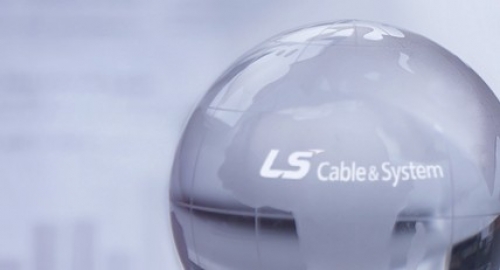Loose Tube, Dry Core FO Cable
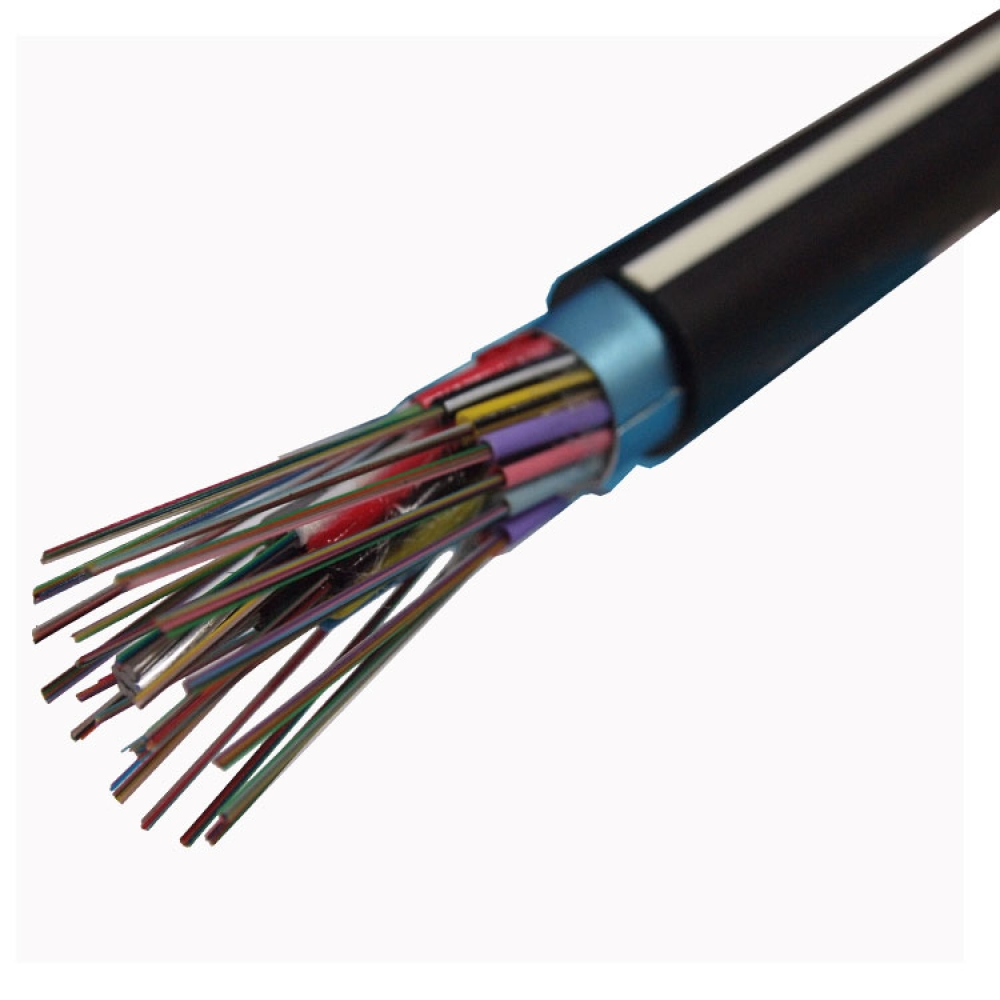
LS Simple™ Fiber Optic Cable is fully designed & developed by LS and can meet variable types of structure and installation requirements based on remarkable Research & Development practices and historic production experiences. LS Fiber Optic Cable can be adopted for variable applications which cover indoor, outdoor, duct and direct burial installation circumstances with essential requirements.
Loose Tube, Dry Core FO Cable
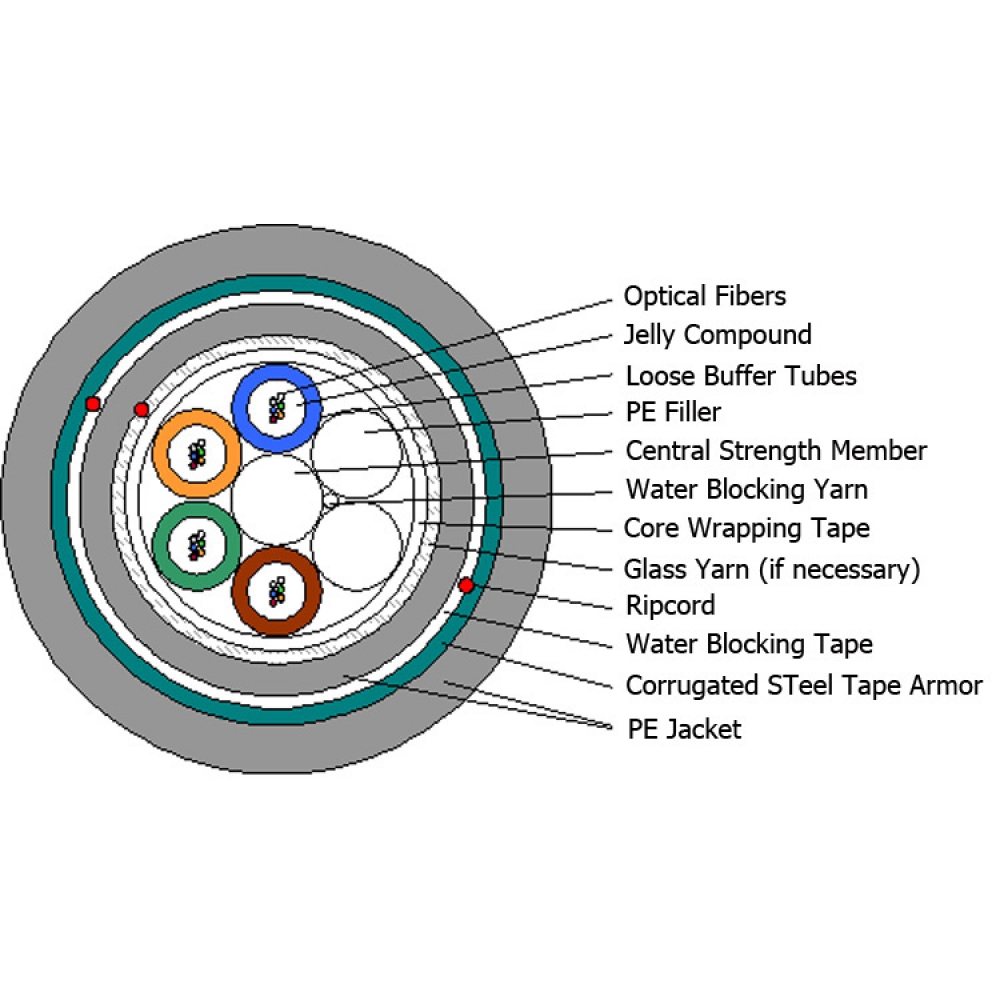
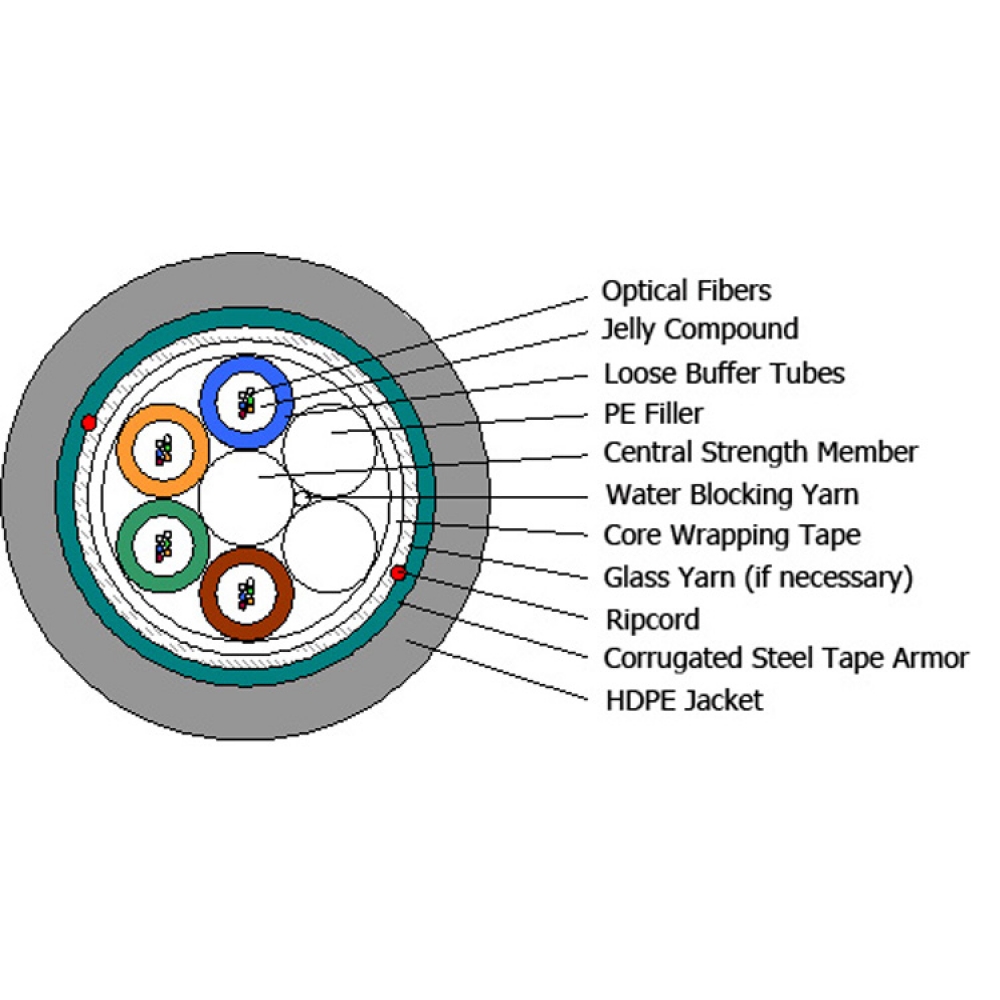
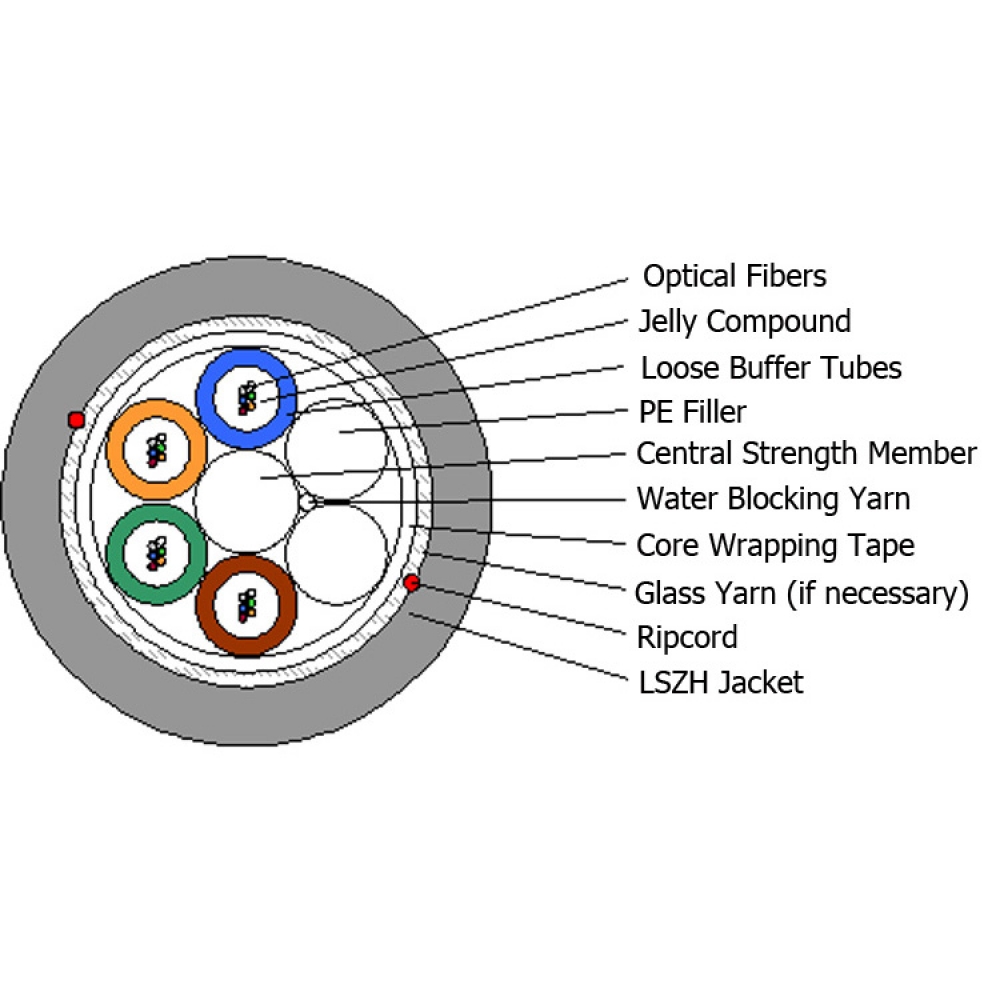


Single-Armored, Double Jacket PE
- Description
- . Fiber Optic Cable
. Loose Tube / Dry Cored / Single-Armored / Double Jacket PE
. Color coded optical fibers, jelly filled color coded loose tubes, PE filler (if necessary), water blocking yarn around central strength member,
SZ-stranded around the dielectric central strength member, core wrapping tape, outer strength member if necessary, water blocking tape if necessary,
ripcord, inner PE jacket, ripcord, corrugated steel tape armor and outer PE jacket
- Cable Construction
ITEMS DESCRIPTION Number of Fibers Max. 576 Max. No. of Fibers per Tube 6 or 12 or 24 Loose Buffer Tube PBT (Polybutylene Terephthalate) Filling Compound
in Loose Buffer TubeThixotropic Jelly Compound Filler Polyethylene Rod (if necessary) Central Strength Member FRP (with PE over-coat if needed) Water Blocking Material Water Blocking Yarn or tape around CSM Core Wrapping Tape Water Blocking Tape Auxiliary Strength Member Glass yarns if necessary Rip Cord One ripcord Inner Jacket Material Black MDPE or HDPE Thickness Nom. 1.0mm Water Blocking Material Water Blocking Tape if needed Rip Cord Two ripcords Armor Material Corrugated Steel Tape with plastic coating Thickness Nom. 0.15mm (Steel tape)
Nom. 0.05mm (Plastic coating on each side)Outer Jacket Material Black MDPE or HDPE Thickness Nom. 1.5mm
- Mechanical and Environmental Performance
ITEMS TEST METHOD AND
ACCEPTANCE CRITERIATensile Strength # Test method: IEC 60794-1-2 Method E1
-. Mandrel diameter: 30D (D = cable diameter)
-. Length under tension: ≥ 50 m
-. Load: 2,700N for 1 hour
# Acceptance Criteria
-. Attenuation increment: ≤ 0.1 dB for SMF
≤ 0.2 dB for MMFCrush Resistance # Test method: IEC 60794-1-2 Method E3
-. Applied load: 2,200 N/10 cm for 10 minutes
-. No of points: 1 point
# Acceptance Criteria
-. Attenuation Increment: ≤ 0.1 dB for SMF
≤ 0.2 dB for MMF
after completion of the test
-. No jacket cracking and no fiber breakageImpact resistance # Test method: IEC 60794-1 Method E4
-. Impact Energy: 10J
-. Radius of impact mass: 25mm
-. No. of impact per point: 1 time at 3 points each
# Acceptance Criteria
-. Attenuation Increment : ≤ 0.1 dB for SMF
≤ 0.2 dB for MMF
after completion of the test
-. No jacket cracking and no fiber breakageCable bend # Test method: IEC 60794-1-2 Method E11A
-. Mandrel diameter: 20D (D = cable diameter)
-. No. of turns: 4 turns(wrapped and unwrapped)
-. No. of flexing cycles: 10 cycles
# Acceptance Criteria
-. Attenuation Increment: ≤ 0.1 dB for SMF
≤ 0.2 dB for MMF
after the completion of the test
-. No jacket cracking and no fiber breakageTorsion # Test method: IEC 60794-1-2 Method E7
-. Cable length twisted: 2m
-. No. of twist cycles: 10 cycles
-. Twist angle: ± 180°
# Acceptance Criteria
-. Attenuation Increment: ≤ 0.1 dB for SMF
≤ 0.2 dB for MMF
after the completion of the test
-. No sheath cracking and no fiber breakageWater Penetration # Test method: IEC 60794-1-2 Method F5
-. Length of specimen: 3m
-. Height of pressure head: 1m
-. Test time: 24 hours
# Acceptance Criteria
-. No leakage through the open cable endTemperature Cycling # Test method: IEC 60794-1-2 Method F1
-. Cable length: at least 1000m
-. At least 6 fibers shall be spliced and tested.
-. Temperature cycling schedule
: 23°C → -40°C → 70°C
-. Soak time at each temperature: 24 hours
-. No of cycles: 2
# Acceptance Criteria
-. Attenuation increment: ≤ 0.1 dB/km for SMF
≤ 0.2 dB/km for MMF
- Application
- Fiber optic telecommunication cables used for outdoor applications

Single-Armored, Single Jacket PE
- Description
- . Fiber Optic Cable
. Loose Tube / Dry Cored / Single-Armored / Single Jacket PE
. Color coded optical fibers, jelly filled color coded loose tubes, PE filler (if necessary), water blocking yarn around central strength member,
SZ-stranded around the dielectric central strength member, core wrapping tape, outer strength member if necessary, water blocking tape if necessary,
ripcord, corrugated steel tape armor and outer PE jacket
- Cable Construction
ITEMS DESCRIPTION Number of Fibers Max. 576 Max. No. of Fibers per Tube 6 or 12 or 24 Loose Buffer Tube PBT (Polybutylene Terephthalate) Filling Compound
in Loose Buffer TubeThixotropic Jelly Compound Filler Polyethylene Rod (if necessary) Central Strength Member FRP (with PE over-coat if needed) Water Blocking Material Water Blocking Yarn or tape around CSM Core Wrapping Tape Water Blocking Tape Auxiliary Strength Member Glass yarns if necessary Water Blocking Material Water Blocking Tape if needed Rip Cord Two ripcords Armor Material Corrugated Steel Tape with plastic coating Thickness Nom. 0.15mm (Steel tape)
Nom. 0.05mm (Plastic coating on each side)Outer Jacket Material Black HDPE Thickness Nom. 1.5mm
- Mechanical and Environmental Performance
ITEMS TEST METHOD AND
ACCEPTANCE CRITERIATensile Strength # Test method: IEC 60794-1-2 Method E1
-. Mandrel diameter: 30D (D = cable diameter)
-. Length under tension: ≥ 50 m
-. Load: 2,700N for 1 hour
# Acceptance Criteria
-. Attenuation increment: ≤ 0.1 dB for SMF
≤ 0.2 dB for MMFCrush Resistance # Test method: IEC 60794-1-2 Method E3
-. Applied load: 2,200 N/10 cm for 10 minutes
-. No of points: 1 point
# Acceptance Criteria
-. Attenuation Increment: ≤ 0.1 dB for SMF
≤ 0.2 dB for MMF
after completion of the test
-. No jacket cracking and no fiber breakageImpact resistance # Test method: IEC 60794-1 Method E4
-. Impact Energy: 10J
-. Radius of impact mass: 25mm
-. No. of impact per point: 1 time at 3 points each
# Acceptance Criteria
-. Attenuation Increment : ≤ 0.1 dB for SMF
≤ 0.2 dB for MMF
after completion of the test
-. No jacket cracking and no fiber breakageCable bend # Test method: IEC 60794-1-2 Method E11A
-. Mandrel diameter: 20D (D = cable diameter)
-. No. of turns: 4 turns(wrapped and unwrapped)
-. No. of flexing cycles: 10 cycles
# Acceptance Criteria
-. Attenuation Increment: ≤ 0.1 dB for SMF
≤ 0.2 dB for MMF
after the completion of the test
-. No jacket cracking and no fiber breakageTorsion # Test method: IEC 60794-1-2 Method E7
-. Cable length twisted: 2m
-. No. of twist cycles: 10 cycles
-. Twist angle: ± 180°
# Acceptance Criteria
-. Attenuation Increment: ≤ 0.1 dB for SMF
≤ 0.2 dB for MMF
after the completion of the test
-. No sheath cracking and no fiber breakageWater Penetration # Test method: IEC 60794-1-2 Method F5
-. Length of specimen: 3m
-. Height of pressure head: 1m
-. Test time: 24 hours
# Acceptance Criteria
-. No leakage through the open cable endTemperature Cycling # Test method: IEC 60794-1-2 Method F1
-. Cable length: at least 1000m
-. At least 6 fibers shall be spliced and tested.
-. Temperature cycling schedule
: 23°C → -40°C → 70°C
-. Soak time at each temperature: 24 hours
-. No of cycles: 2
# Acceptance Criteria
-. Attenuation increment: ≤ 0.1 dB/km for SMF
≤ 0.2 dB/km for MMF
- Application
- Fiber optic telecommunication cables used for outdoor applications

Non-Armored, Single Jacket LSZH
- Description
- Fiber Optic Cable
. Loose Tube / Dry Cored / Non-Armored / Single Jacket LSZH
. Color coded optical fibers, jelly filled color coded loose tubes, PE filler (if necessary), water blocking yarn around central strength member,
SZ-stranded around the dielectric central strength member, core wrapping tape, outer strength member if necessary, ripcord and outer jacket
- Cable Construction
ITEMS DESCRIPTION Number of Fibers Max. 576 Max. No. of Fibers per Tube 6 or 12 or 24 Loose Buffer Tube PBT (Polybutylene Terephthalate) Filling Compound
in Loose Buffer TubeThixotropic Jelly Compound Filler Polyethylene Rod (if necessary) Central Strength Member FRP (with PE over-coat if needed) Water Blocking Material Water Blocking Yarn or tape around CSM Core Wrapping Tape Water Blocking Tape Auxiliary Strength Member Glass yarns if necessary Rip Cord One Rip cord Outer Jacket Material Black LSZH Thickness Nom. 1.8mm
- Mechanical and Environmental Performance
ITEMS TEST METHOD AND
ACCEPTANCE CRITERIATensile Strength # Test method: IEC 60794-1-2 Method E1
-. Mandrel diameter: 30D (D = cable diameter)
-. Length under tension: ≥ 50 m
-. Load: 2,700N for 1 hour
# Acceptance Criteria
-. Attenuation increment: ≤ 0.1 dB for SMF
≤ 0.2 dB for MMFCrush Resistance # Test method: IEC 60794-1-2 Method E3
-. Applied load: 1,100 N/10 cm for 10 minutes
-. No of points: 1 point
# Acceptance Criteria
-. Attenuation Increment: ≤ 0.1 dB for SMF
≤ 0.2 dB for MMF
after completion of the test
-. No jacket cracking and no fiber breakageImpact resistance # Test method: IEC 60794-1 Method E4
-. Impact Energy: 5J
-. Radius of impact mass: 25mm
-. No. of impact per point: 1 time at 3 points each
# Acceptance Criteria
-. Attenuation Increment : ≤ 0.1 dB for SMF
≤ 0.2 dB for MMF
after completion of the test
-. No jacket cracking and no fiber breakageCable bend # Test method: IEC 60794-1-2 Method E11A
-. Mandrel diameter: 20D (D = cable diameter)
-. No. of turns: 4 turns(wrapped and unwrapped)
-. No. of flexing cycles: 10 cycles
# Acceptance Criteria
-. Attenuation Increment: ≤ 0.1 dB for SMF
≤ 0.2 dB for MMF
after the completion of the test
-. No jacket cracking and no fiber breakageTorsion # Test method: IEC 60794-1-2 Method E7
-. Cable length twisted: 2m
-. No. of twist cycles: 10 cycles
-. Twist angle: ± 180°
# Acceptance Criteria
-. Attenuation Increment: ≤ 0.1 dB for SMF
≤ 0.2 dB for MMF
after the completion of the test
-. No sheath cracking and no fiber breakageWater Penetration # Test method: IEC 60794-1-2 Method F5
-. Length of specimen: 3m
-. Height of pressure head: 1m
-. Test time: 24 hours
# Acceptance Criteria
-. No leakage through the open cable endTemperature Cycling # Test method: IEC 60794-1-2 Method F1
-. Cable length: at least 1000m
-. At least 6 fibers shall be spliced and tested.
-. Temperature cycling schedule
: 23°C → -40°C → 70°C
-. Soak time at each temperature: 24 hours
-. No of cycles: 2
# Acceptance Criteria
-. Attenuation increment: ≤ 0.1 dB/km for SMF
≤ 0.2 dB/km for MMFFlame retardant In compliance with IEC 60332-1
- Application
- Fiber optic telecommunication cables used for indoor/outdoor applications

Non-Armored, Single Jacket PE
- Description
- . Fiber Optic Cable
. Loose Tube / Dry Cored / Non-Armored / Single Jacket PE
. Color coded optical fibers, jelly filled color coded loose tubes, PE filler (if necessary), water blocking yarn around central strength member,
SZ-stranded around the dielectric central strength member, core wrapping tape, outer strength member if necessary, ripcord and outer PE jacket
- Cable Construction
ITEMS DESCRIPTION Number of Fibers Max. 576 Max. No. of Fibers per Tube 6 or 12 or 24 Loose Buffer Tube PBT (Polybutylene Terephthalate) Filling Compound
in Loose Buffer TubeThixotropic Jelly Compound Filler Polyethylene Rod (if necessary) Central Strength Member FRP (with PE over-coat if needed) Water Blocking Material Water Blocking Yarn or tape around CSM Core Wrapping Tape Water Blocking Tape Auxiliary Strength Member Glass yarns if necessary Rip Cord One Ripcord Outer Jacket Material Black MDPE or HDPE Thickness Nom. 1.5mm
- Physical / Mechanical / Environmental Performance
ITEMS TEST METHOD AND ACCEPTANCE CRITERIA Tensile Strength # Test method: IEC 60794-1-2 Method E1
-. Mandrel diameter: 30D (D = cable diameter)
-. Length under tension: ≥ 50 m
-. Load: 2,700N for 1 hour
# Acceptance Criteria
-. Attenuation increment: ≤ 0.1 dB for SMF
≤ 0.2 dB for MMFCrush Resistance # Test method: IEC 60794-1-2 Method E3
-. Applied load: 1,100 N/10 cm for 10 minutes
-. No of points: 1 point
# Acceptance Criteria
-. Attenuation Increment: ≤ 0.1 dB for SMF
≤ 0.2 dB for MMF
after completion of the test
-. No jacket cracking and no fiber breakageImpact resistance # Test method: IEC 60794-1 Method E4
-. Impact Energy: 5J
-. Radius of impact mass: 25mm
-. No. of impact per point: 1 time at 3 points each
# Acceptance Criteria
-. Attenuation Increment : ≤ 0.1 dB for SMF
≤ 0.2 dB for MMF
after completion of the test
-. No jacket cracking and no fiber breakageCable bend # Test method: IEC 60794-1-2 Method E11A
-. Mandrel diameter: 20D (D = cable diameter)
-. No. of turns: 4 turns(wrapped and unwrapped)
-. No. of flexing cycles: 10 cycles
# Acceptance Criteria
-. Attenuation Increment: ≤ 0.1 dB for SMF
≤ 0.2 dB for MMF
after the completion of the test
-. No jacket cracking and no fiber breakageTorsion # Test method: IEC 60794-1-2 Method E7
-. Cable length twisted: 2m
-. No. of twist cycles: 10 cycles
-. Twist angle: ± 180°
# Acceptance Criteria
-. Attenuation Increment: ≤ 0.1 dB for SMF
≤ 0.2 dB for MMF
after the completion of the test
-. No sheath cracking and no fiber breakageWater Penetration # Test method: IEC 60794-1-2 Method F5
-. Length of specimen: 3m
-. Height of pressure head: 1m
-. Test time: 24 hours
# Acceptance Criteria
-. No leakage through the open cable endTemperature Cycling # Test method: IEC 60794-1-2 Method F1
-. Cable length: at least 1000m
-. At least 6 fibers shall be spliced and tested.
-. Temperature cycling schedule
: 23°C → -40°C → 70°C
-. Soak time at each temperature: 24 hours
-. No of cycles: 2
# Acceptance Criteria
-. Attenuation increment: ≥ 0.1 dB/km for SMF
≥ 0.2 dB/km for MMF
- Application
- Fiber optic telecommunication cables used for outdoor applications



